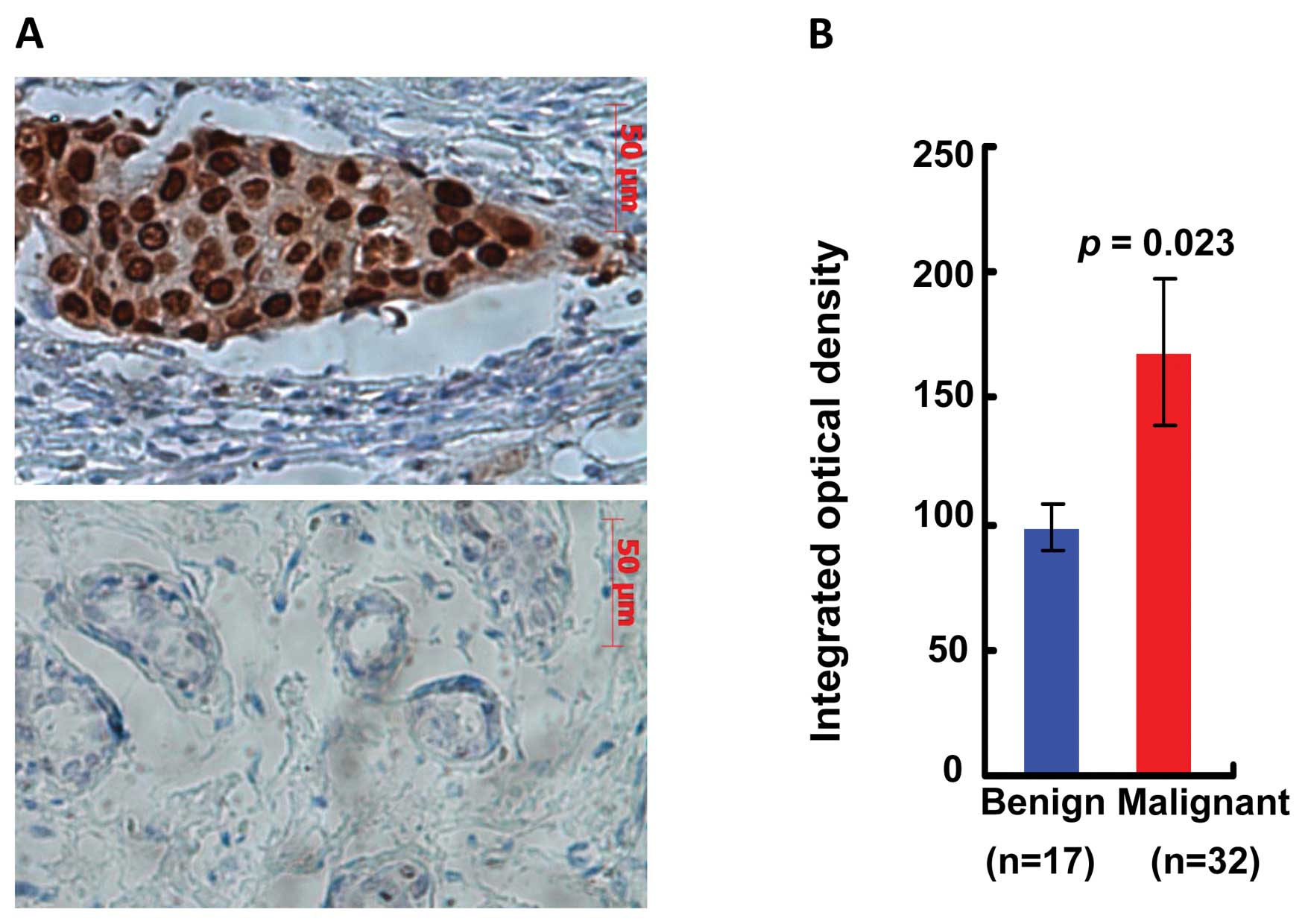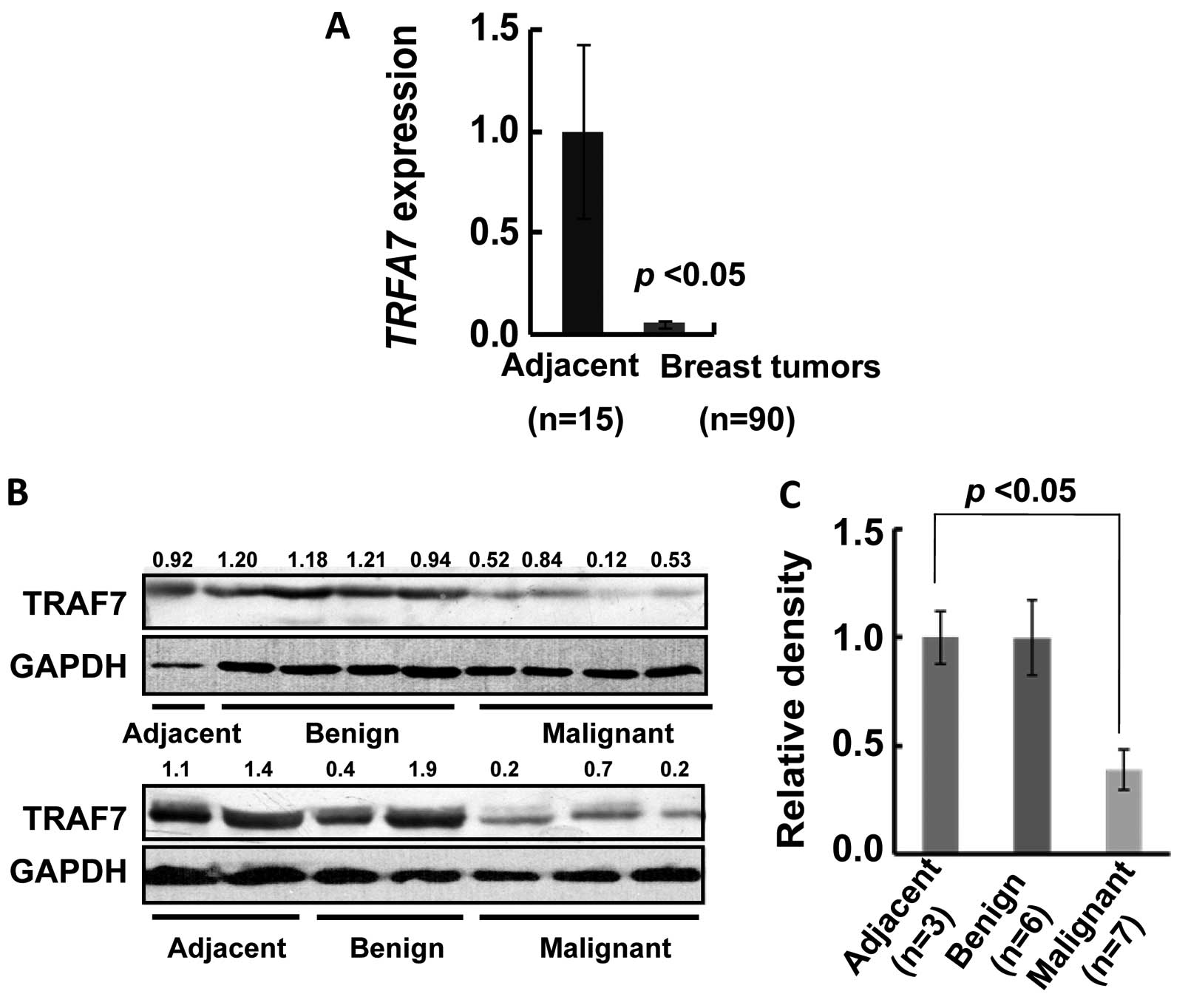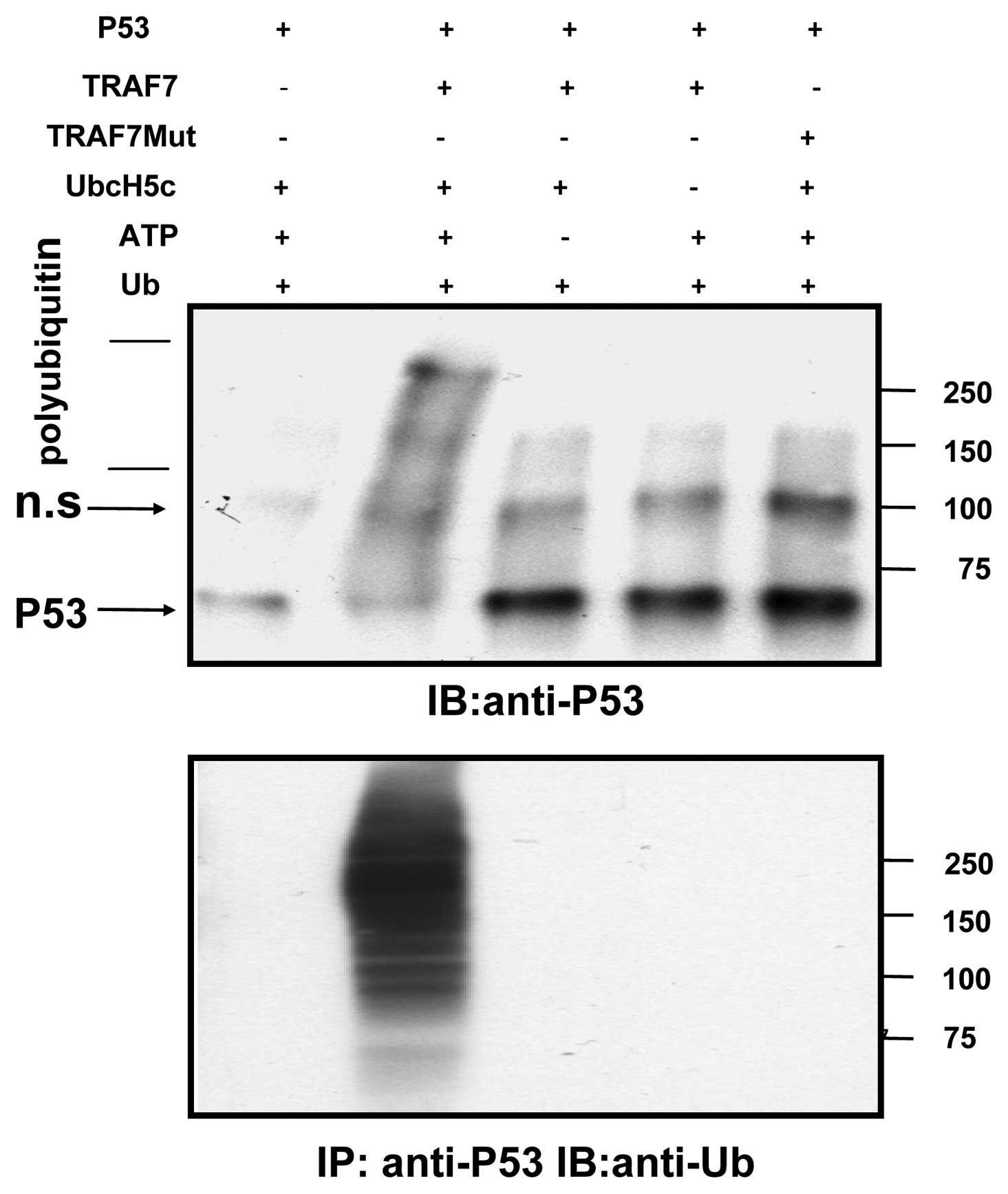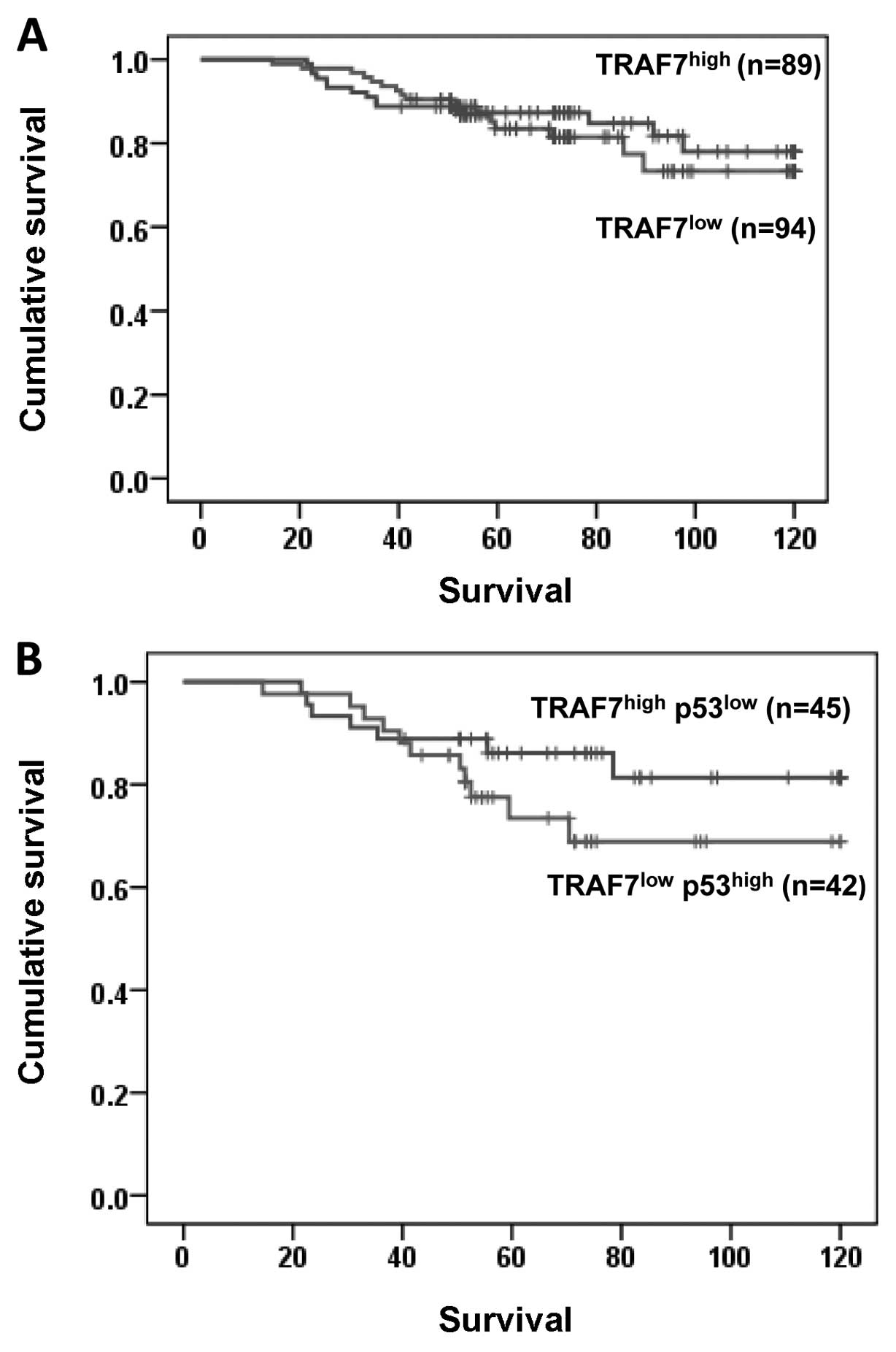Introduction
In normal cells, the wild-type (wt) p53 protein is
rapidly degraded by the proteasome and therefore has a short
half-life. MDM2 is a p53-induced ubiquitin E3 ligase, which in turn
targets p53 for degradation. When mutant p53 loses its
trans-activating function, it cannot induce MDM2, leading to
the accumulation of p53. However, the accumulation of wt p53 has
also been observed in some human tumors. The tumor suppressor
protein, p53, is encoded by the TP53 in humans. Its
fundamental function is to guard the integrity of the genome, and
thus prevent cancer initiation. p53 exerts an anticancer function
through a number of mechanisms including its significant role in
apoptosis, DNA repair and cell cycle regulation. In normal cells,
the p53 protein is maintained at a rather low level via a
continuous degradation. On the one hand, the binding of MDM2 to p53
prohibits its transcriptional activities and enhances its
transportation from nucleus into cytoplasm; on the other hand,
MDM2, as an E3 ubiquitin ligase, covalently ubiquitinates p53 and
subjects p53 for degradation by proteasomes. Approximately 50% of
human tumors have an increased concentration of the p53 protein
(1). The increased p53 level is due
to genetic mutations in most cases; meanwhile, p53 accumulation
often remains in wt in the other cases. The impairment of p53
degradation and its functional deficiency might account for the
accumulation of wt p53 in cancer cells. Nonetheless, the abundance
of wt p53 is sufficiently compensated and well tolerated in cancer
cells.
TNF receptor-associated factor 7 (TRAF7) is an E3
ubiquitin ligase for several proteins involved in the NF-κB
pathway, such as c-FLIP (2), NF-κB
essential modulator (NEMO) and the p65 subunit of NF-κB
transcription factor (3,4). Here, we demonstrated that TARF7 was an
E3 ligase for p53 and reduction of TRAF7 led to cytosolic
accumulation of p53. In the breast tumor specimens enlisted in the
present study, pronounced p53 accumulation was observed,
particularly in cytoplasm; however, gene sequencing analysis
suggested an extremely low frequency of mutation in the p53
gene in these tumors. Meanwhile, largely downregulated TRAF7
expression was found in these tumors, correlating with the high
levels of p53. TRAF7 downregulation therefore might, at least
partially, explain the mechanism responsible for wt p53
accumulation in breast tumors. Additionally, TRAF7
downregulation indicated poor prognosis in a breast cancer cohort,
particularly with concomitant upregulation of p53. These
data collectively suggested that TRAF7 plays an important role in
stabilizing p53, and TRAF7 deregulation results in defects in the
p53 degradation pathway. The deregulation of the TRAF7/p53 axis
likely contributes to the development of breast cancer.
Materials and methods
Breast tumor specimens
All tumor specimens from breast cancer patients were
obtained from the Wendeng Central Hospital, Shandong, China. The
analyses of the human tumor specimens were conducted according to
the guidelines of the ethics committee at the Wendeng Central
Hospital, and were also approved by the ethics committee at RCEES,
Chinese Academy of Sciences.
Immunohistochemical assay
The p53 monoclonal antibody DO-7 was purchased from
Santa Cruz Biotechnology. Evaluation of the immunohistochemical
analysis was conducted blindly without knowledge of the clinical
and pathological characteristics of the patients. The intensity of
p53 staining was quantified with the software Image-Pro Plus.
Mutation spectrum analysis of the p53
gene
Breast tumor samples were analyzed for DNA sequence
mutations within the exons 4–9 of the p53 gene as previously
described (5,6). Briefly, DNA was isolated from tumor
tissues with QIAamp DNA Micro kit (Qiagen). PCR products were
purified with QIAquick Gel Extraction kit (Qiagen) and sequenced in
Sangon Biotech Co., Ltd. (Shanghai, China). Primers for PCR
amplification are listed in Table
I.
 | Table IPrimers used in the current study for
exons 4–9 of the p53 gene. |
Table I
Primers used in the current study for
exons 4–9 of the p53 gene.
| Location | Primer sequence
(5′-3′) |
|---|
| Exon 4 | Forward:
cctggtcctctgactgctcttttcaccca
Reverse: ggccaggcattgaagtctcat |
| Exon 5 | Forward:
atctgttcacttgtgccctgactttc
Reverse: accctgggcaaccagccctgtc |
| Exon 6 | Forward:
agagacgacagggctggttg
Reverse: cttaacccctcctcccagag |
| Exon 7 | Forward:
ctcctaggttggctctg
Reverse: gaggctggggcacagcaggccagtg |
| Exon 8 | Forward:
ccttactgcctcttgcttct
Reverse: ataactgcacccttggtctc |
| Exon 9 | Forward:
ggagaccaagggtgcagttatgcctcag
Reverse: cccaattgcaggtaaaacag |
Ubiquitination assay in vitro
In vitro ubiquitination assays were performed
according to the manufacturer’s manual (Boston Biochem). E1,
UbcH5c, ubiquitin and reaction buffer were purchased from Boston
Biochem. Recombinant p53 was purchased from BD Pharmingen. TRAF7
and TRAF7 mutant (with RING domain deletion) were purified from 293
cells expressing FLAG-TRAF7 or mutant.
qRT-PCR analysis
qRT-PCR analysis was performed as previously
described (7). Primer sequences for
human TRAF7 in PCR analysis were: forward, 5′-GTGTGGTGTCTCTGCG
TCTAC-3′; reverse, 5′-ACACAATGATGGTGCAGTCTG-3′. GAPDH was used as
the internal control. The primer sequences for GAPDH were: forward,
5′-GAAGGTGAAGGTCGGA GT-3′; reverse, 5′-GAAGATGGTGATGGGATTTC-3′.
Western blot analysis
Western blot analysis for TRAF7 was performed as
previously described (8). The
intensities of TRAF7 bands were quantified with ImageJ and
normalized to GAPDH. Anti-GAPDH and anti-TRAF7 antibodies were
purchased from Santa Cruz Biotechnology and Abcam,
respectively.
Survival analysis in a breast cancer
cohort
A cohort dataset was used to assess the correlation
between the altered expression of TRAF7 and p53 and
the prognosis in breast cancer patients. The dataset was generated
using Illumina HumanHT-12 v3 Expression BeadChips from 183 primary
breast cancer samples. The normalized mRNA expression data were
obtained from the GEO database (GEO ID: GSE 24450) (9). The mean value of p53 and
TRAF7 expression were used as threshold to determine
expression levels. Overall survival was analyzed by the method of
Kaplan-Meier plot.
Statistical analysis
The two-tailed Student’s t-test was used to analyze
experimental data. Data are shown as the means ± SE. P<0.05 was
considered to indicate statistically significant differences.
Results
Accumulation of p53 in breast tumors
p53 protein levels were examined in 30 benign and 36
malignant tumors using immunohistochemical assays. Three distinct
staining levels (negative, weak positive and positive) were
characterized according to the staining intensity (Fig. 1A). In total, 30% (9 out of 30) of
the benign tumors were p53 negative, while only 8% (3 out of 36) of
the malignant tumors were negative (Table II). By contrast, 89% of the
malignant tumors (32 out of 36) showed p53 positive while 57% of
the benign tumors (17 out of 30) were p53 positive (Table II). There was a significant
increase of the integrated optical density for the p53 staining in
malignant tumors when compared to the benign tumors (P<0.05)
(Fig. 1B). Moreover, we observed
more pronounced cytoplasmic retention of p53 in malignant tumors
than in benign tumors (Table II),
indicating the critical role of p53 in breast cancer as reported by
previous studies (10,11).
 | Table IIImmunohistochemical analysis of p53 in
breast cancer specimens. |
Table II
Immunohistochemical analysis of p53 in
breast cancer specimens.
| Pattern | Benign tumors | Malignant tumors |
|---|
| Negative | 30% (9/30) | 8% (3/36) |
| Weak positive | 13% (4/30) | 3% (1/36) |
| Positive | 57% (17/30) | 89% (32/36) |
| Grade of cytosolic
staining | ++ | +++ |
| Grade of nuclear
staining | + | + |
p53 mutation in breast tumors
To elucidate the mechanism underlying p53
accumulation in our breast tumor samples, we examined p53
mutations in all tumor samples by DNA sequencing of the exons from
4 to 9. No mutation was detected from exons 5 to 9 in all samples.
A missense mutation in exon 4 was found in 1 out of 98 tumor
samples (Table III). A to G point
mutation (Val→Ala) at codon 103 in exon 4 was characterized.
Numerous p53 mutations block the MDM2-mediated p53 degradation.
However, no p53 mutation was detected in almost all our breast
tumors, suggesting that the increase of p53 is not due to gene
mutation as previously observed (11,12).
Therefore, other E3 ligases may be responsible for p53 degradation
in these tumors.
 | Table IIISequencing results of p53 genomic DNA
from tumors. |
Table III
Sequencing results of p53 genomic DNA
from tumors.
| No. of patients | No. of mutation | Mutation type | Frequency |
|---|
| Exon 4 | 98 | 1a | A→G (Val→Ala) | 1.02% |
| Exon 5 | 102 | 0 | | 0 |
| Exon 6 | 104 | 0 | | 0 |
| Exon 7 | 101 | 0 | | 0 |
| Exon 8 | 99 | 0 | | 0 |
| Exon 9 | 97 | 0 | | 0 |
Downregulation of TRAF7 expression in
breast cancer
To search for other possible E3 ligases for p53, the
mRNA expression of E3 ligases was examined using qRT-PCR. We found
the E3 ligase TRAF7 mRNA level was largely reduced in breast
tumors compared to the corresponding adjacent tissues (P<0.05)
(Fig. 3A). TRAF7 protein was also
markedly reduced in tumor specimens compared to adjacent tissues
(Fig. 3B and C). The correlation
between the reduction of TRAF7 and the increase of p53 suggests
that TRAF7 may be an E3 ligase targeting p53 degradation.
TRAF7-mediated ubiquitination of p53
TRAF family members play a central role in the
regulation of the TNF signaling pathway, especially in modulating
the activation of NF-κB (13).
Similar to the other TRAF family member, the RING domain of TRAF7
determines its function of E3 ubiquitin ligase (14). To test whether p53 was a potential
target of TRAF7 for ubiquitination, we performed the in
vitro ubiquitination assay. As shown in Fig. 2, p53 underwent K48-linked
polyubiquitination in the presence of TRAF7. By contrast, no
ubiquitinated p53 was detected when a TRAF7 mutant without the RING
domain was added. These data suggest that TRAF7 polyubiquitinates
p53 through the RING domain, which leads to p53 degradation.
Correlation between TRAF7 downregulation
and poor prognosis
To validate the role of TRAF7 on p53, a public
breast cancer cohort was used to evaluate the effect of
TRAF7 expression on the survival of breast cancer patients
using the Kaplan-Meier survival curves. As shown in Fig. 4A, a poorer prognosis was predicted
in patients with low TRAF7 expression than in patients with
high TRAF7 expression. Moreover, patients with low
TRAF7 and high p53 expression
(TRAF7lowp53high) showed a
significant lower survival rate than patients with high
TRAF7 and low p53 expression
(TRAF7highp53low) (Fig. 4B). These observations suggest the
critical role of TRAF7 on the prognosis of breast cancer by
regulating p53 degradation.
Discussion
Ubiquitin-mediated degradation is the only way in
which p53 is terminated by proteasomes (15). A few E3 ligases of p53 have been
discovered thus far, of which MDM2 is the most cardinal one
(16). In normal cells, a low level
of p53 is maintained by its rapid degradation in a
ubiquitin-dependent manner. Impairment of the p53 degradation
pathway would cause its abnormal retention. Additionally, p53’s
functional deficiency might also interpret its accumulation in wt
without involving structural mutations within the p53 gene
itself, such as cytosolic retention of p53 and its binding with
blocking proteins (17,18). Thus, increased wt p53 level in
cancer suggests that the p53 functional signaling and/or
degradation signaling is damaged to a certain degree, leading to
defects in p53 protein degradation and deficiencies in its normal
functions, which however is compensated and tolerated in cancer
cells.
The accumulation of wt p53 has also been found in
breast cancer (11,12,15).
However, the mechanism that leads to p53 accumulation is not yet
well understood. In this study, we demonstrated that the E3 ligase
TRAF7 could target p53 and increase its ubiquitination, suggesting
a critical role of TRAF7 in regulating p53’s protein stability. We
observed p53 accumulation and corresponding TRAF7 downregulation in
breast tumors, indicating the correlation between TRAF7
deregulation and p53 stabilization. Moreover, p53 accumulation was
found to be prominently localized in cytoplasm, suggesting
remarkable deficiencies of p53 functions in these tumors.
Additionally, TRAF7 downregulation was verified to predict
poor prognosis in breast cancer patients, particularly with a
concomitant of p53 upregulation. The combined data signified
the importance of the TRAF7/p53 axis in modulating breast cancer
development. Similar to the results from the current study,
previous studies have also revealed that ungoverned p53 even in wt
could significantly enhance tumor initiation and progression due to
deregulation of the p53 network such as a fundamental switch of the
expression pattern of its target genes (19,20).
For example, defects in MDM2’s binding to p53 resulted in promoting
wt p53 accumulation, leading to enhanced tumor progression in
non-small cell lung cancer (21).
To the best of our knowledge, we are the first to
find that TRAF7 is an E3 ligase targeted for p53 degradation.
Meanwhile, we demonstrated that dramatic downregulation of TRAF7
expression in breast tumor specimens correlated with high levels of
wt p53 protein in these tumors. Collectively, these results
indicated that the accumulation of wt p53 in tumors was due to
defects in the process of p53 degradation, and TRAF7 downregulation
largely contributed to provoke p53 cytosolic retention and its
functional deficiencies. Therefore, the deregulated TRAF7/p53 axis
presumably plays a crucial role in breast cancer development, and
strategies targeting this axis might represent a novel approach to
restrain tumor progression in breast cancer.
Acknowledgements
This study was supported by grants from the Chinese
Academy of Sciences (KZCX2-EW-404), the National Natural Science
Foundation of China (grant nos. 21077128, 20921063, 21177151) and
from the program of ‘Hundreds Talents’ of the Chinese Academy of
Sciences. We thank the lab members for their significant assistance
with experiments and reagents.
References
|
1
|
Hollstein M, Sidransky D, Vogelstein B and
Harris C: p53 mutations in human cancers. Science. 253:49–53. 1991.
View Article : Google Scholar : PubMed/NCBI
|
|
2
|
Scudiero I, Zotti T, Ferravante A, et al:
Tumor necrosis factor (TNF) receptor-associated factor 7 is
required for TNFα-induced Jun NH2-terminal kinase activation and
promotes cell death by regulating polyubiquitination and lysosomal
degradation of c-FLIP protein. J Biol Chem. 287:6053–6061.
2012.
|
|
3
|
Zotti T, Uva A, Ferravante A, et al: TRAF7
protein promotes Lys-29-linked polyubiquitination of IκB kinase
(IKKγ)/NF-κB essential modulator (NEMO) and p65/RelA protein and
represses NF-κB activation. J Biol Chem. 286:22924–22933.
2011.PubMed/NCBI
|
|
4
|
Tsikitis M, Acosta-Alvear D, Blais A, et
al: Traf7, a MyoD1 transcriptional target, regulates nuclear
factor-κB activity during myogenesis. EMBO Rep. 11:969–976.
2010.PubMed/NCBI
|
|
5
|
Patocs A, Zhang L, Xu Y, et al:
Breast-cancer stromal cells with TP53 mutations and nodal
metastases. N Engl J Med. 357:2543–2551. 2007. View Article : Google Scholar : PubMed/NCBI
|
|
6
|
Kusser WC, Levin DB and Glickman BW:
Sensitive two-stage PCR of p53 genomic DNA exons 5–9. PCR Methods
Appl. 2:250–252. 1993.
|
|
7
|
Liu S, Goldstein RH, Scepansky EM and
Rosenblatt M: Inhibition of rho-associated kinase signaling
prevents breast cancer metastasis to human bone. Cancer Res.
69:8742–8751. 2009. View Article : Google Scholar : PubMed/NCBI
|
|
8
|
Liu S, Li S and Du Y: Polychlorinated
biphenyls (PCBs) enhance metastatic properties of breast cancer
cells by activating Rho-associated kinase (ROCK). PLoS One.
5:e112722010. View Article : Google Scholar : PubMed/NCBI
|
|
9
|
Jamshidi M, Bartkova J, Greco D, et al:
NQO1 expression correlates inversely with NFκB activation in human
breast cancer. Breast Cancer Res Treat. 132:955–968. 2012.
|
|
10
|
Silvestrini R, Daidone MG, Benini E, et
al: Validation of p53 accumulation as a predictor of distant
metastasis at 10 years of follow-up in 1400 node-negative breast
cancers. Clin Cancer Res. 2:2007–2013. 1996.PubMed/NCBI
|
|
11
|
Sjögren S, Inganäs M, Norberg T, et al:
The p53 gene in breast cancer: prognostic value of complementary
DNA sequencing versus immunohistochemistry. J Natl Cancer Inst.
88:173–182. 1996.
|
|
12
|
Moll UM, Riou G and Levine AJ: Two
distinct mechanisms alter p53 in breast cancer: mutation and
nuclear exclusion. Proc Natl Acad Sci USA. 89:7262–7266. 1992.
View Article : Google Scholar : PubMed/NCBI
|
|
13
|
Häcker H, Tseng PH and Karin M: Expanding
TRAF function: TRAF3 as a tri-faced immune regulator. Nat Rev
Immunol. 11:457–468. 2011.PubMed/NCBI
|
|
14
|
Zotti T, Vito P and Stilo R: The seventh
ring: exploring TRAF7 functions. J Cell Physiol. 227:1280–1284.
2012. View Article : Google Scholar : PubMed/NCBI
|
|
15
|
Lacroix M, Toillon RA and Leclercq G: p53
and breast cancer, an update. Endocr Relat Cancer. 13:293–325.
2006. View Article : Google Scholar : PubMed/NCBI
|
|
16
|
Lee JT and Gu W: The multiple levels of
regulation by p53 ubiquitination. Cell Death Differ. 17:86–92.
2009.
|
|
17
|
O’Brate A and Giannakakou P: The
importance of p53 location: nuclear or cytoplasmic zip code? Drug
Resist Updat. 6:313–322. 2003.PubMed/NCBI
|
|
18
|
Liang SH and Clarke MF: Regulation of p53
localization. Eur J Biochem. 268:2779–2783. 2001. View Article : Google Scholar : PubMed/NCBI
|
|
19
|
Mullany LK, Liu Z, King ER, Wong KK and
Richards JS: Wild-type tumor repressor protein 53 (Trp53) promotes
ovarian cancer cell survival. Endocrinology. 153:1638–1648. 2012.
View Article : Google Scholar : PubMed/NCBI
|
|
20
|
Houben R, Hesbacher S, Schmid CP, et al:
High-level expression of wild-type p53 in melanoma cells is
frequently associated with inactivity in p53 reporter gene assays.
PLoS One. 6:e220962011. View Article : Google Scholar : PubMed/NCBI
|
|
21
|
Wang YC, Lin RK, Tan YH, Chen JT, Chen CY
and Wang YC: Wild-type p53 overexpression and its correlation with
MDM2 and p14ARF alterations: an alternative pathway to non-small
cell lung cancer. J Clin Oncol. 23:154–164. 2005. View Article : Google Scholar : PubMed/NCBI
|


















